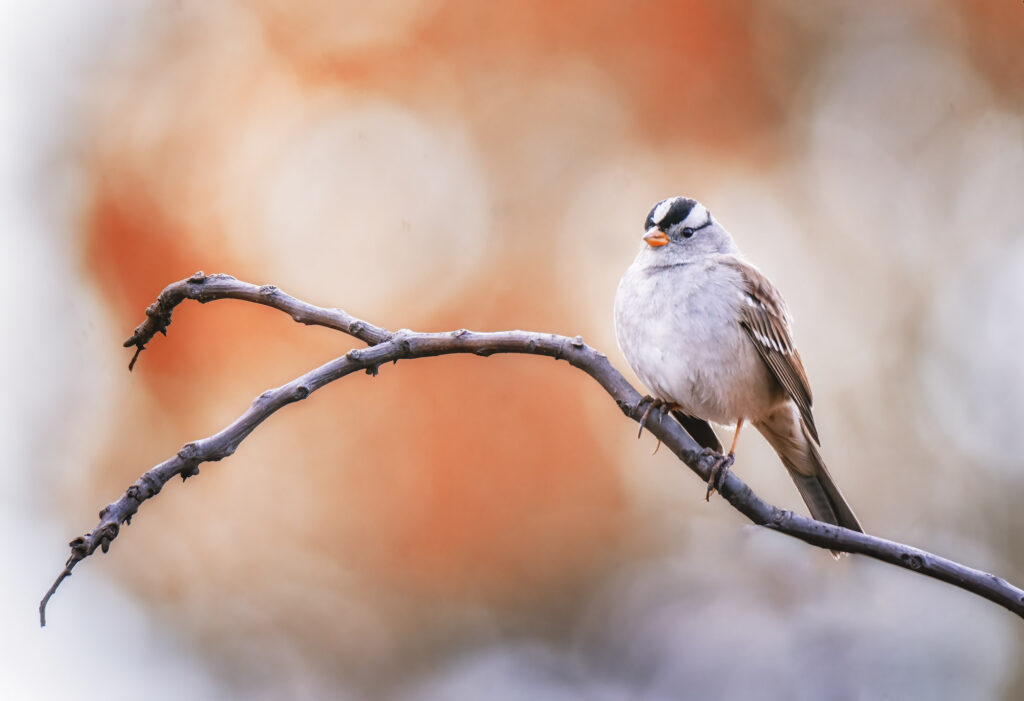Pennsylvania is a birdwatcher’s paradise. With 436 species of wild birds calling the state home, there is something for every type of birder to enjoy. From the towering bald eagles that soar overhead to the tiny sparrows that flit through the underbrush, Pennsylvania is a birdwatcher’s dream.
We recently put together a Pennsylvania Bird Guide that gives an overview of some of the fascinating birds in the state, including woodpeckers, jays, bluebirds, hummingbirds, orioles, grouse, and plenty of songbirds.
Sparrows are one of the most common types of birds in Pennsylvania. There are 17 species of sparrows that are regularly found in Pennsylvania – some in the summer, some in the winter, some all year, and some as they migrate between winter and summer grounds.
We love sparrows at Wild Bird Scoop. They are small, unassuming birds, but they are also incredibly adaptable and resilient. They can be found in a wide range of habitats, and they can survive in even the harshest conditions.
What Makes a Sparrow a Sparrow?
Sparrows are small, brown birds with short tails and stout bills. They are members of the family Passeridae, which includes over 500 species of birds found all over the world. Sparrows are known for their chirping songs and their ability to adapt to a wide variety of habitats.
They are also called “Little Brown Jobs,” or “LBJs” because they tend to all kind of blur together as small, brown, streaky birds. However, it is definitely possible to learn to identify each kind of sparrow by paying close attention to the small differences in their markings. Behavioral clues can also help!
How To Tell Different Birds Apart, Especially Sparrows
There are a few key things to look for when trying to differentiate one kind of sparrow from another. When you spot a sparrow, take note of everything you can from this list:
- Size: Sparrows vary in size, from the tiny Chipping Sparrow to the larger White-crowned Sparrow. If there is another bird nearby that you recognize, take note of the size of the sparrow in comparison to the bird that you already know.
- Color: Sparrows can be a variety of colors, including brown, gray, black, and white. All sparrows have distinctive markings, but some are much more subtle than others. Pay attention to the colors and patterns of the bird, including its wings, chest, belly, neck, nape, head, crown, etc.
- Song: Sparrows have a variety of beautiful songs, which can help to identify them. For example, the Chipping Sparrow has a short, sharp chirp, while the White-throated Sparrow has a long, clear whistle. The Vesper Sparrow sings in the evening. During the winter, it can be harder to identify sparrows by song, as they do most of their singing during the breeding season. However, they probably still make calls to one another in the winter, so listen for those instead.
- Habitat: Sparrows can be found in a variety of habitats, but some species are more common in certain areas. For example, the Chipping Sparrow is often found in open fields, while the Swamp Sparrow is more likely to be found in marshes. Take note of where you saw the sparrow.
How Many Sparrows Are in Pennsylvania?
Sparrows are incredibly populous. Even several of the species that are declining in population are still some of the most common birds in North America.
There are at least 17 sparrows that are found in Pennsylvania. Our list does not include birds like the Clay-colored Sparrow, which is very rare in PA but has been spotted here a few times. That’s because we want this list to be an effective tool in identifying the sparrows you are most likely to see in the Keystone State.
Our list is divided into four categories: Sparrows in Pennsylvania all year round, sparrows who just stay for the summer, sparrows who just stay during the winter, and sparrows who are likely to make a stop during their migration.
Let’s get started on our list!
Sparrows in Pennsylvania Year-Round
There are a few sparrows who live in Pennsylvania year-round. These include non-migratory sparrows and short-distance migrants whose breeding and winter territories are close together. The sparrows you will see in Pennsylvania all year are the Field Sparrow, the House Sparrow, and the Song Sparrow.
Field Sparrow
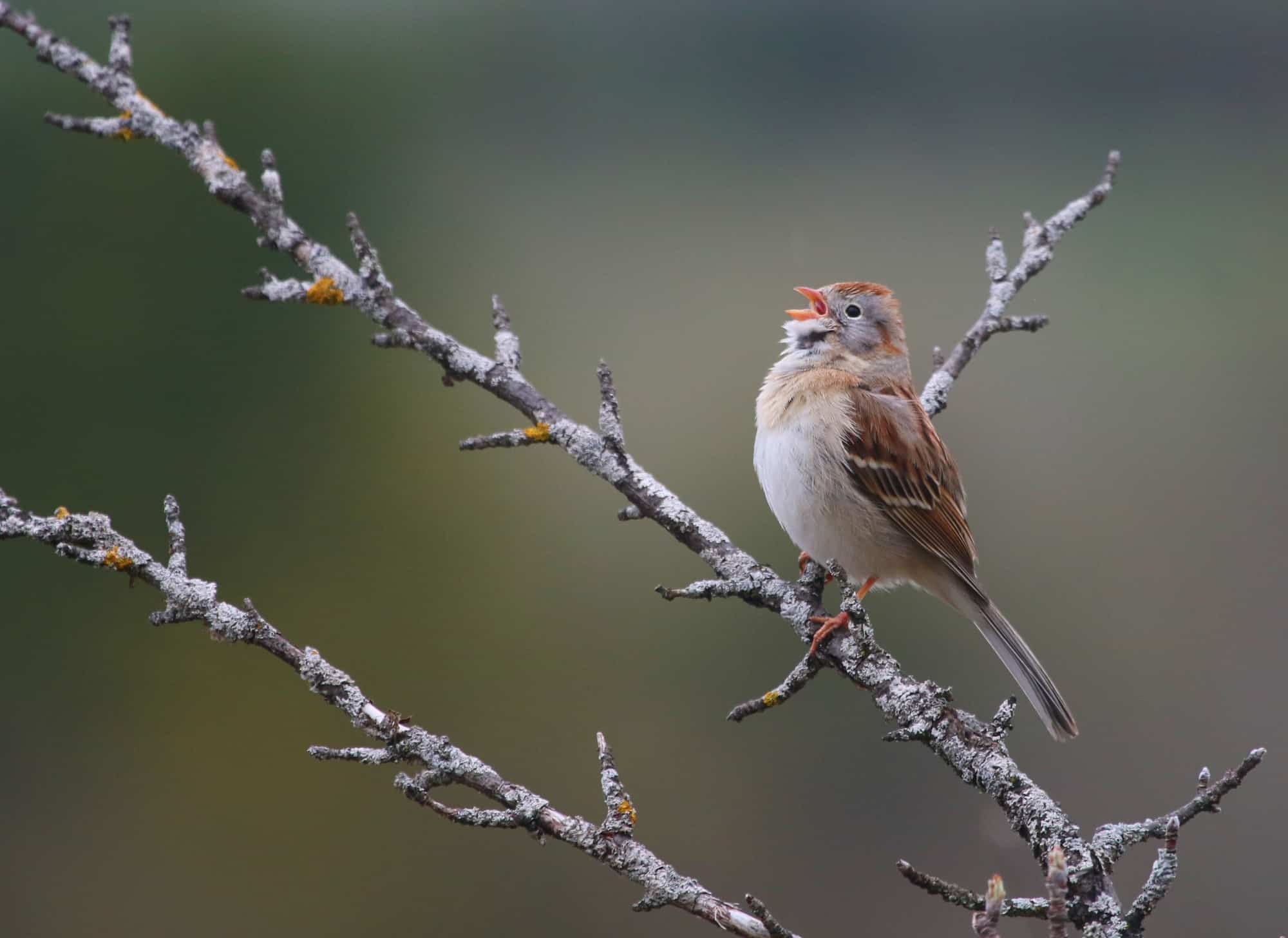
- Scientific name: Spizella pusilla
- Order: Passeriformes
- Family: Emberizidae
- Length: 5.1-5.7 inches (13-14 cm)
- Weight: 0.4-0.6 oz (11-16 g)
- Wingspan: 7.5-8.7 inches (19-22 cm)
The Field Sparrow has a recognizable chestnut-colored cap and white throat. Its belly and chest are grayish-white, and it has a thick rufous line stretching out from behind the eye. The Field Sparrow’s brown wings are streaked in black.
Field Sparrows thrive in old fields that are shrubby and a bit overgrown. One of the ways they protect themselves is by nesting in thick, thorny brushes like overgrown roses and briars. They eat a lot of insects in the summer, and in the winter, their diet switches to the more readily-available seeds and berries.
They are year-round residents of Pennsylvania, although they are less likely to be found along the state’s northern border in the winter.
House Sparrow
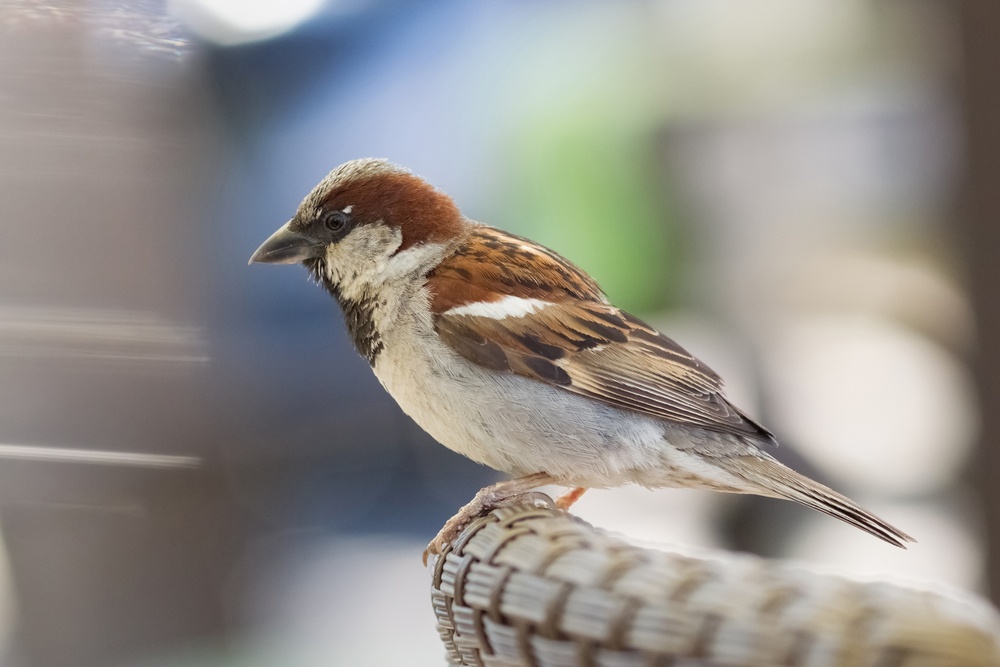
- Scientific name: Passer domesticus
- Order: Passeriformes
- Family: Passeridae
- Length: 5.5-6.7 inches (14-17 cm)
- Weight: 0.7-1.2 oz (20-35 g)
- Wingspan: 9.8-11.8 inches (25-30 cm)
The House Sparrow is a small, brown bird that is found all over the world. It is one of the most common birds in the world, with an estimated population of 1.6 billion individuals.
The house sparrow has a distinctive appearance, with a brown back, a white breast, and a black bib. The sexes are similar in appearance, but the male is slightly larger than the female.
House sparrows are found in a variety of habitats, including urban areas, agricultural areas, and forests. They are very adaptable birds and can live in a wide range of conditions.
In Pennsylvania, house sparrows are found throughout the state, all year. They are more common in urban areas, but they can also be found in rural areas. That said, even in rural areas, they will build their nests and live near humans and human-built structures.
Here are some interesting facts about the house sparrow:
- They are social birds and live in flocks.
- They are omnivorous and eat a variety of foods, including seeds, insects, and berries.
- They are very good at adapting to new environments.
- They are one of the most common urban birds in the world.
- Their population has declined in recent years due to competition from other bird species and habitat loss. That said, the House Sparrow is not considered to be threatened or endangered.
Song Sparrow

- Scientific name: Melospiza melodia
- Order: Passeriformes
- Family: Emberizidae
- Length: 5.5-6.7 inches (14-17 cm)
- Weight: 0.7-1.2 oz (20-35 g)
- Wingspan: 9.8-11.8 inches (25-30 cm)
The Song Sparrow is a small, brown sparrow that is comfortable in a number of habitats, including forests, fields, and gardens. It is a common bird in North America and is also found in parts of Central and South America.
The Song Sparrow has a fairly muted appearance, with a brown back, white breast, and black streaks. Males are slightly larger than females. Look for the little reddish-brown streak that extends backward from each eye.
Pennsylvania is home to numerous Song Sparrows, which are year-long residents. Most of them don’t migrate, although there may be some Canada-breeding Song Sparrows in Pennsylvania during the winter.
They build their nests on the ground and lay 4-6 eggs, which incubate for only 12-ish days. They are ready to leave the nest within 2 weeks of hatching! Although their population has declined a bit over time, they are a Species of Least Concern.
Sparrows in Pennsylvania in the Summer
There are more sparrows in Pennsylvania during the summer than at any other point in the year. These include the Chipping Sparrow, the Eastern Towhee, the Field Sparrow, the Grasshopper Sparrow, the Henslow’s Sparrow, the Savannah Sparrow, and the Vesper Sparrow (remember that in addition to this list, the House and Song Sparrows are also here during the summer.)
Chipping Sparrow
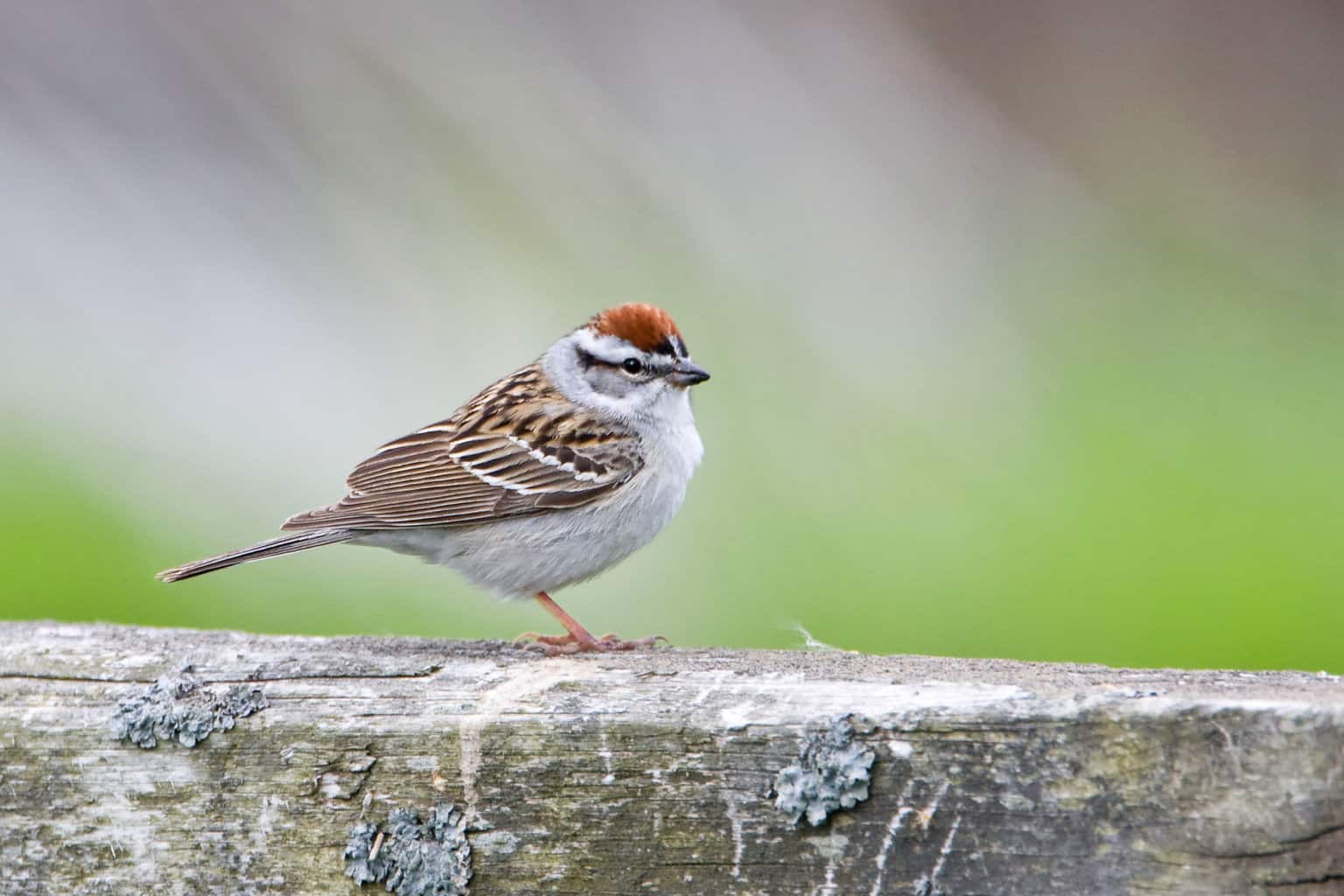
- Scientific name: Spizella passerina
- Order: Passeriformes
- Family: Emberizidae
- Length: 4.7-5.9 inches (12-15 cm)
- Weight: 0.4-0.6 oz (11-16 g)
- Wingspan: 8.3 inches (21 cm)
The Chipping Sparrow is a small, brown sparrow with a distinctive black cap and white cheeks. There are not really any significant differences between males and females. To identify the Chipping Sparrow, look for the black line that runs from the bill to the eye, and then from the eye toward the back of the head.
The Chipping Sparrow is found more often in open habitats rather than in well-covered ones, such as woodlands, fields, gardens, and backyards. It is a common bird in North America with some populations in Central America, too. In Pennsylvania, you’ll see Chipping Sparrows throughout the state, all summer long.
Their diet consists of insects, seeds, and berries, which they find by foraging on the ground. They also build their nests on the ground, laying about 4-6 eggs. The eggs incubate for 12 days, and hatchlings leave the nest after 13 days.
Eastern Towhee

- Scientific name: Pipilo erythrophthalmus
- Order: Passeriformes
- Family: Emberizidae
- Length: 6.3-7.5 inches (16-19 cm)
- Weight: 0.7-1.1 oz (20-30 g)
- Wingspan: 9.8-11.8 inches (25-30 cm)
The Eastern Towhee is a larger sparrow with a distinctive black head, rufous sides, and white belly. It is easier to recognize than many of the sparrows on this list, as it is not a traditionally streaked sparrow. They are generally considered to be sexually monomorphic, with minimal differences in appearance between males and females.
The Eastern Towhee lives in a number of different kinds of habitats, including forests, open fields, and backyards. As its name implies, it is found almost exclusively in the eastern half of North America. It is a breeding-season resident of Pennsylvania and can be found throughout the state.
The Eastern Towhee’s diet consists of insects during the summer and seeds and berries during the winter. Female Eastern Towhees manage the nest construction, which they build on the ground. Like smaller sparrows, their nest holds about 4-6 eggs, which incubate for 12 days. Within 13 days, the babies are ready to leave the nest.
Eastern Towhees will often raise Brown-headed Cowbirds in their nests without realizing it, thanks to brood parasitism.
Grasshopper Sparrow
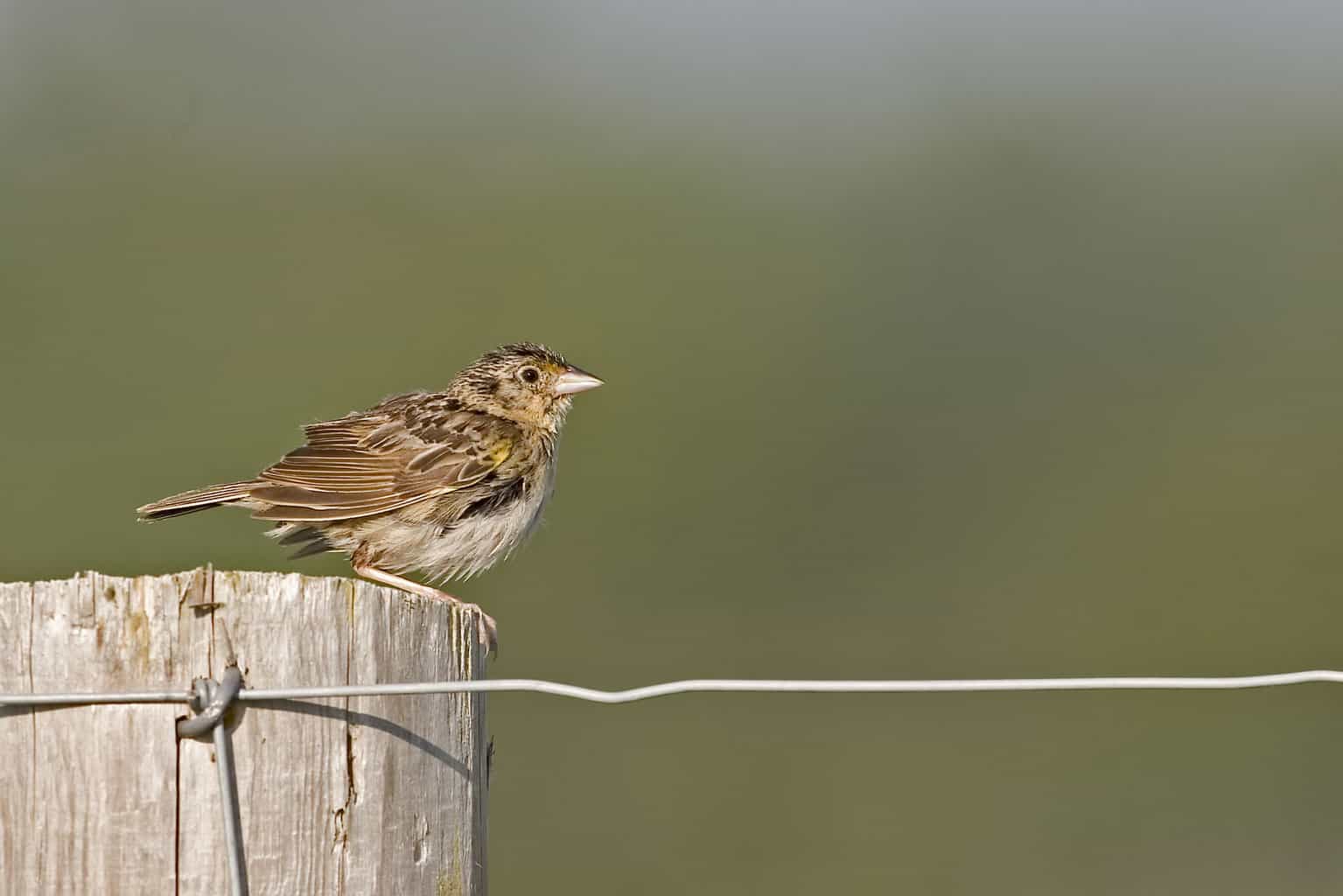
- Scientific name: Ammodramus savannarum
- Order: Passeriformes
- Family: Emberizidae
- Length: 5.3-5.7 inches (13-14 cm)
- Weight: 0.3-0.5 oz (9-14 g)
- Wingspan: 7.1-8.3 inches (18-21 cm)
The cute little Grasshopper Sparrow is a small brown and buff sparrow with yellow lores (a bird’s lore is the space between its eye and its bill). The Grasshopper Sparrow’s head is flattened at the top, and its bill is quite long.
Although there are several subvarieties of Grasshopper Sparrows, most look very similar to one another. The only one that looks significantly different is the Florida Grasshopper Sparrow, which is darker in color. It is also endangered, whereas generally, Grasshopper Sparrows are considered a Species of Least Concern. Their numbers are declining, but not at a concerning rate.
The Grasshopper Sparrow eats insects, seeds, and berries. It eats grasshoppers, but that’s not where it gets its name. Rather, it gets its name from the buzzy sound it makes as a call. You are more likely to hear the Grasshopper Sparrow than see one, as the bird is quite shy.
The Grasshopper Sparrow is found in a variety of habitats, including open grasslands, meadows, and marshes. It is a common bird in North America and is also found in parts of Central and South America.
Pennsylvania is home to breeding Grasshopper Sparrows all summer. They are widespread throughout the state.
Henslow’s Sparrow
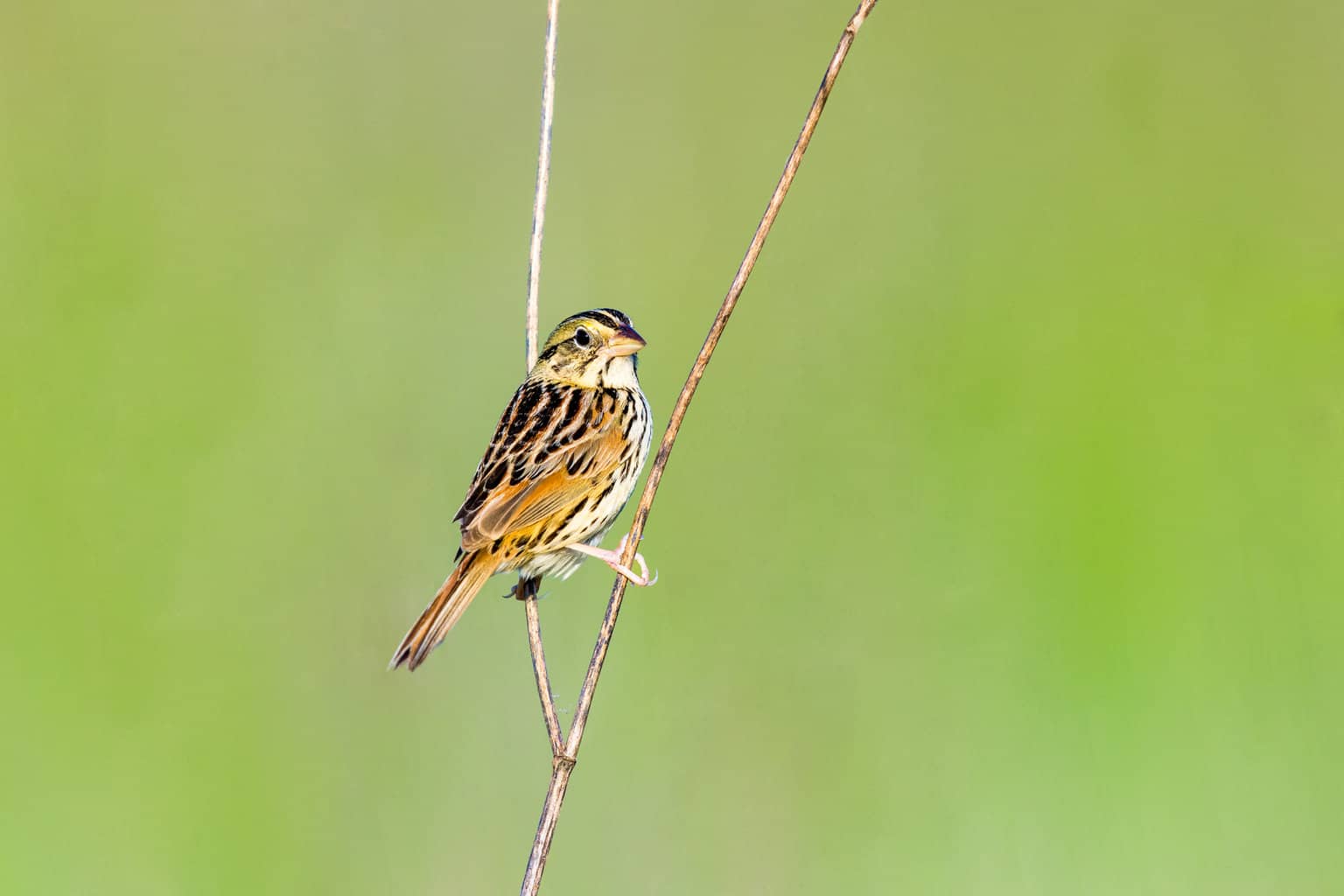
- Scientific name: Ammodramus henslowii
- Order: Passeriformes
- Family: Emberizidae
- Length: 5.1-5.7 inches (13-14 cm)
- Weight: 0.3-0.5 oz (9-14 g)
- Wingspan: 7.1-8.3 inches (18-21 cm)
The Henslow’s Sparrow is a small, brown sparrow with a greenish-yellow wash over most of its body and black and white stripes on its head. They often hide among the tall grasses of their preferred open habitat. They are quite shy and hard to spot.
Henslow’s Sparrows have a relatively small breeding territory and an even smaller winter territory. They mostly breed in the Midwest and a little farther east, and they spend the winter along the Atlantic coast. In Pennsylvania, they can be found throughout most of the state, but they tend to avoid the Northeast and Southeast regions.
Henslow’s Sparrows sound a bit like grasshoppers buzzing, too, which is similar to the Grasshopper Sparrow.
Savannah Sparrow

- Scientific name: Passerculus sandwichensis
- Order: Passeriformes
- Family: Emberizidae
- Length: 5.3-6.3 inches (13-16 cm)
- Weight: 0.6-1.0 oz (17-28 g)
- Wingspan: 7.9-9.1 inches (20-23 cm)
The Savannah Sparrow is a small, brown sparrow that is found in open habitats, such as meadows, fields, and marshes. It has a distinctive appearance, with a brown back, white breast, and black streaks on its back and wings. There are minimal differences between males and females, but there is a lot of variation from one region to the next.
Savannah Sparrows prefer open habitats–fields, meadows, and marshes, for example. They are common in Pennsylvania during the summer breeding season.
As ground-nesting birds, Savannah Sparrows eat insects all summer long, which helps with controlling pest populations, such as beetles, grasshoppers, flies, and even spiders.
Despite experiencing depopulation over the last several decades, Savannah Sparrows are considered to be species of Least Concern, according to conservationists.
Vesper Sparrow
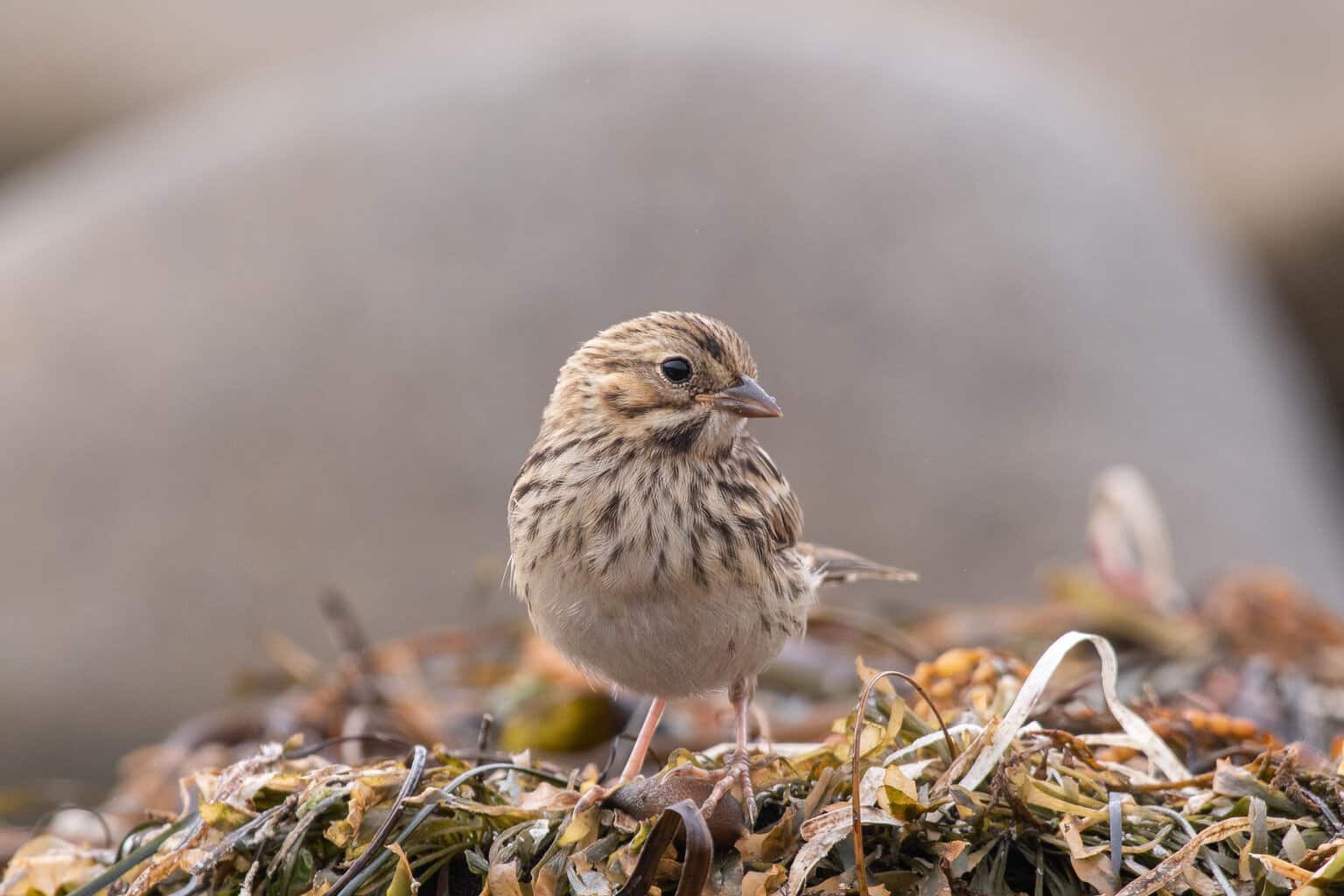
- Scientific name: Pooecetes gramineus
- Order: Passeriformes
- Family: Emberizidae
- Length: 5.3-6.3 inches (13-16 cm)
- Weight: 0.4-0.6 oz (11-16 g)
- Wingspan: 7.1-8.3 inches (18-21 cm)
The Vesper Sparrow is a small sparrow with minimal markings. It is somewhat pale in color with light brown streaks over most of its body. Its most identifiable marking is a chestnut-colored patch on the shoulder. Males and females look alike.
Vesper Sparrows are found in many different habitats. They live in fields, meadows, and open woodlands. While many sparrows in this list live in wetlands and marshes, Vesper Sparrows avoid wet areas and tall grasses.
They breed throughout Pennsylvania and can be heard during the daytime and especially at dusk. They get their name from the sweet, pretty song they sing at dusk, at the same time that some Christian traditions hold a vesper prayer service.
Sparrows in Pennsylvania in the Winter
There are just a few kinds of sparrows that spend just the winter in Pennsylvania. These are the American Tree Sparrow, the Dark-eyed Junco, and the White-throated Sparrow.
American Tree Sparrow
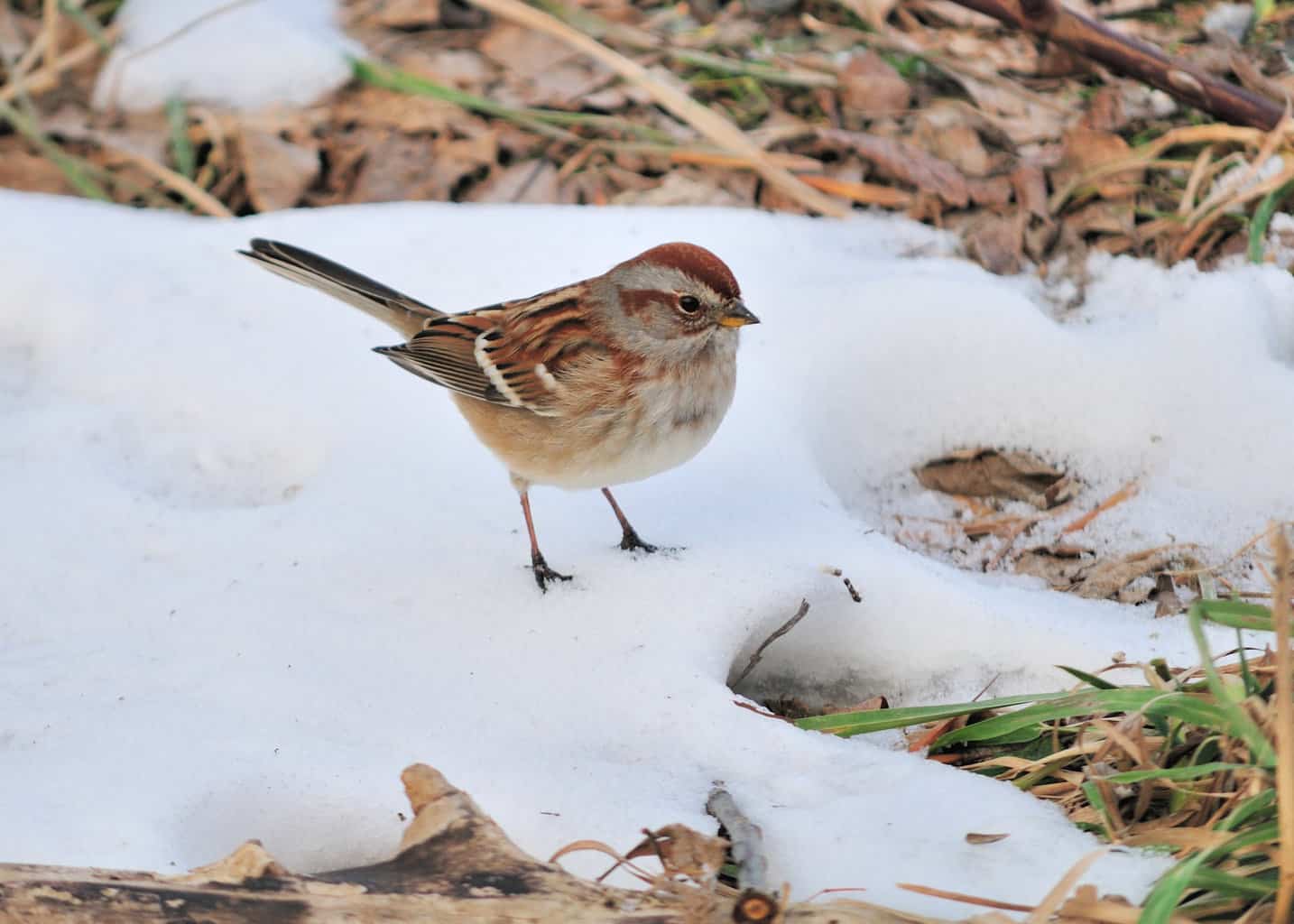
- Scientific name: Spizella arborea
- Order: Passeriformes
- Family: Emberizidae
- Length: 5.5-6.3 inches (14-16 cm)
- Weight: 0.5-1.0 oz (13-28 g)
- Wingspan: 7.1-8.3 inches (18-21 cm)
The little American Tree Sparrow is a plump brown sparrow with a streaky, rufous-brown cap.
The American Tree Sparrow is found in a variety of habitats, including open woodlands, fields, and gardens. It is a common bird in North America and is also found in parts of Central and South America. In Pennsylvania, American Tree Sparrows are found throughout the state, but they are more common in the eastern part of the state.
They got the name “Tree Sparrow” because they look similar to the Eurasian Tree Sparrow. However, they are pretty much exclusively ground-dwelling sparrows who nest on the ground and forage for insects, seeds, and berries.
Dark-eyed Junco
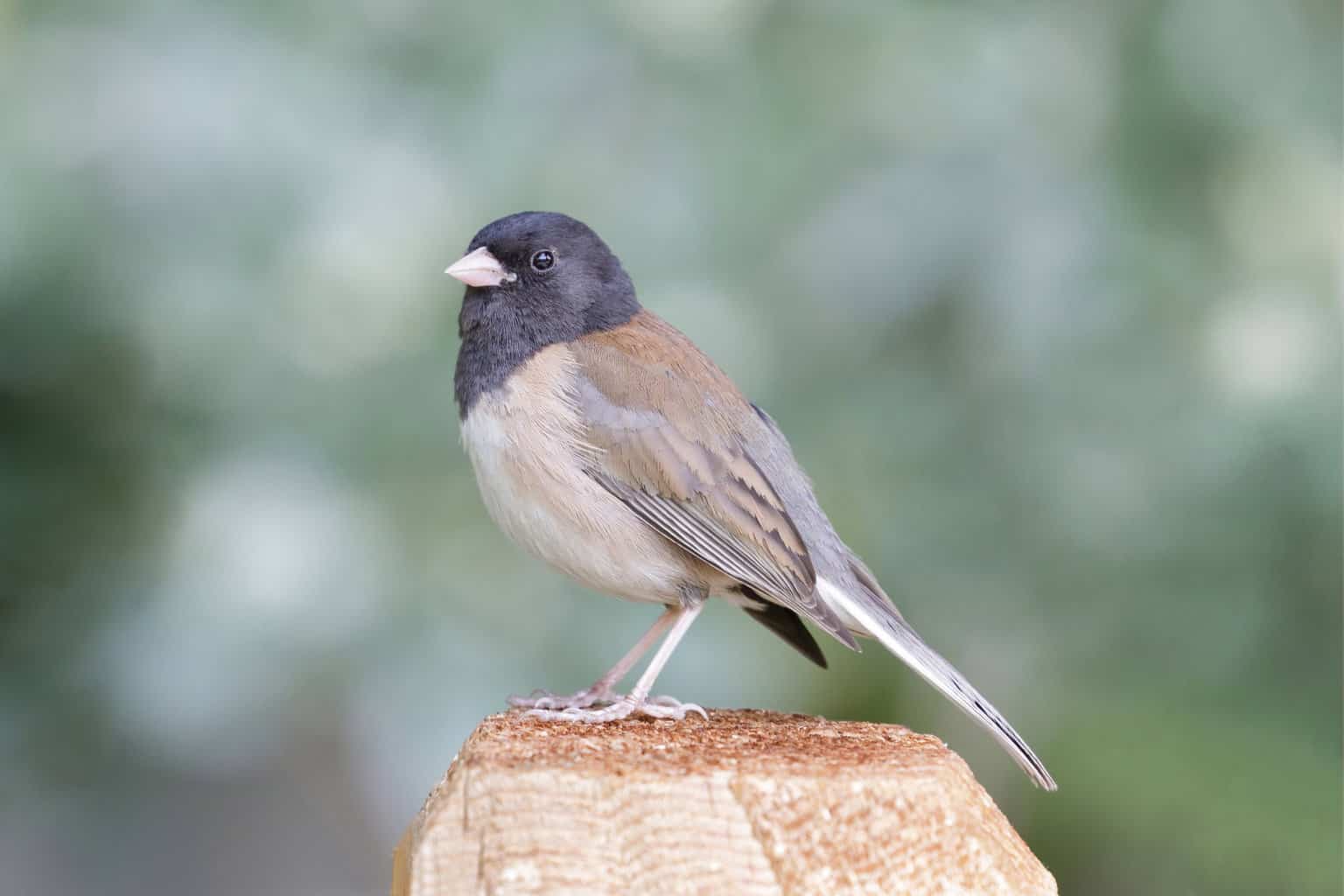
- Scientific name: Junco hyemalis
- Order: Passeriformes
- Family: Emberizidae
- Length: 5.5-6.3 inches (14-16 cm)
- Weight: 0.5-0.7 oz (14-20 g)
- Wingspan: 7.1-8.3 inches (18-21 cm)
The Dark-eyed Junco is a small, round bird with an identifiable black hood and white belly. Females are slightly lighter in color than their male counterparts.
The Dark-eyed Junco is strongly associated with winter in most of the US. In fact, they are frequently called “Snowbirds” on account of their winter arrival and their presence at birdfeeders during the winter. Even though lots of other sparrows are found in Pennsylvania during the winter, Dark-eyed Juncos are some of the most easily noticed!
They are year-round residents of Northcentral PA, but winter-only residents of most of the rest of the state. Look for them along forests and fields, and under backyard seed feeders, where they prefer millet to sunflower seeds.
White-throated Sparrow
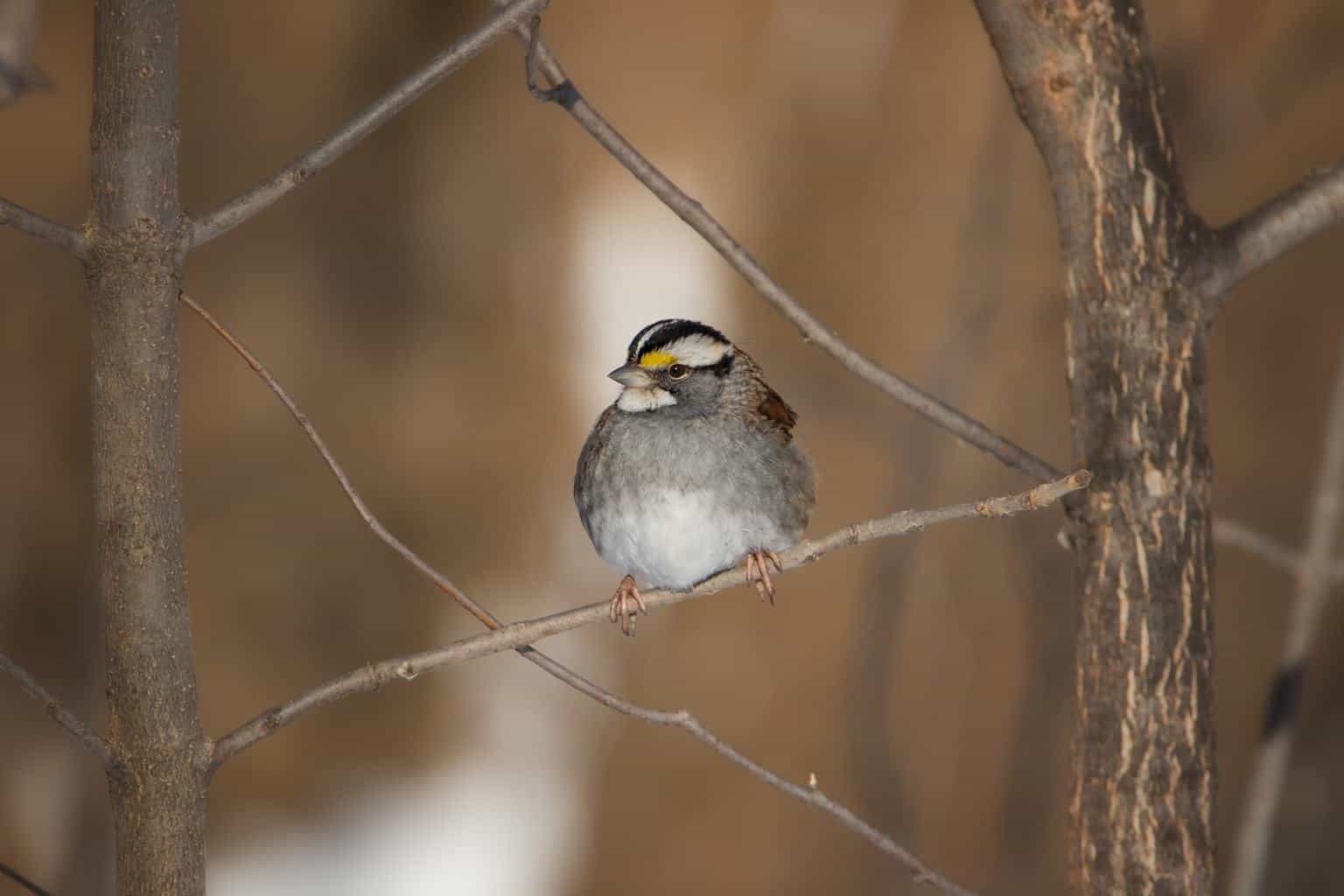
- Scientific name: Zonotrichia albicollis
- Order: Passeriformes
- Family: Emberizidae
- Length: 5.5-6.3 inches (14-16 cm)
- Weight: 0.5-0.7 oz (14-20 g)
- Wingspan: 7.1-8.3 inches (18-21 cm)
The White-throated Sparrow is very easy to identify, thanks to its dramatically patterned white stripe down the middle of its head, which is lined with dark brown stripes on either side. The White-throated Sparrow male and female are pretty much indistinguishable from one another.
White-throated Sparrows adapt to several different habitats, including forests, backyards, and fields. They are common in North America. Specifically, they breed in Canada and spend the winter in the US Midwest, Southeast, Northeast, South, and Pacific Coast. They migrate through the Plains States.
In Pennsylvania, White-throated Sparrows are primarily winter visitors, although there are some permanent residents in the northern parts of the state.
Sparrows in Pennsylvania During Migration
There are several sparrows that make their way through Pennsylvania as they migrate between winter and summer territories. This means that you will see these birds in the fall or spring. They are the Fox Sparrow, the Lincoln’s Sparrow, the Nelson’s Sparrow, the Swamp Sparrow, and the White-crowned Sparrow.
Fox Sparrow

- Scientific name: Passerella iliaca
- Order: Passeriformes
- Family: Emberizidae
- Length: 6.3-7.5 inches (16-19 cm)
- Weight: 0.7-1.1 oz (20-30 g)
- Wingspan: 9.8-11.8 inches (25-30 cm)
The medium-sized Fox Sparrow is hard to describe because there is so much regional variation in its appearance! They are usually rusty-brown with a grayish head and a brown patch on the chest. The amount of streaking on its body can vary significantly from one region to the next. They have sturdy legs, too.
The Fox Sparrow is mostly found in coniferous forests, of which there are plenty in Pennsylvania. During the winter, they live in the southern half of the state. In the northern half of Pennsylvania, you will really only see them during their spring and fall migrations.
Fox Sparrows eat seeds, berries, and plenty of insects. The ones you’ll see in Pennsylvania tend to look reddish-brown. They flock together in the winter, so look for them in groups.
Lincoln’s Sparrow

- Scientific name: Melospiza lincolnii
- Order: Passeriformes
- Family: Emberizidae
- Length: 5.3-6.3 inches (13-16 cm)
- Weight: 0.5-0.7 oz (14-20 g)
- Wingspan: 7.1-8.3 inches (18-21 cm)
Meet the Lincoln’s Sparrow, a small, streaky brown sparrow with rusty edges on both its wings and tail. It has a buff-colored mustache and eyering, as well as a dark eye line. The Lincoln’s Sparrow has a brown and black striped crown with a gray stripe right down the middle.
Lincoln’s Sparrows thrive in forests and fields. When they migrate through Pennsylvania, they usually stop in brushy fields and along forest edges, or in thickets. They need a lot of cover to feel safe.
They build their nests on the ground, where they spend most of their time. They eat beetles, moths, leafhoppers, caterpillars, and aphids during the summer. Sometimes, they will visit backyard feeders that are on the ground, but most of the time, they stay undercover.
Nelson’s Sparrow
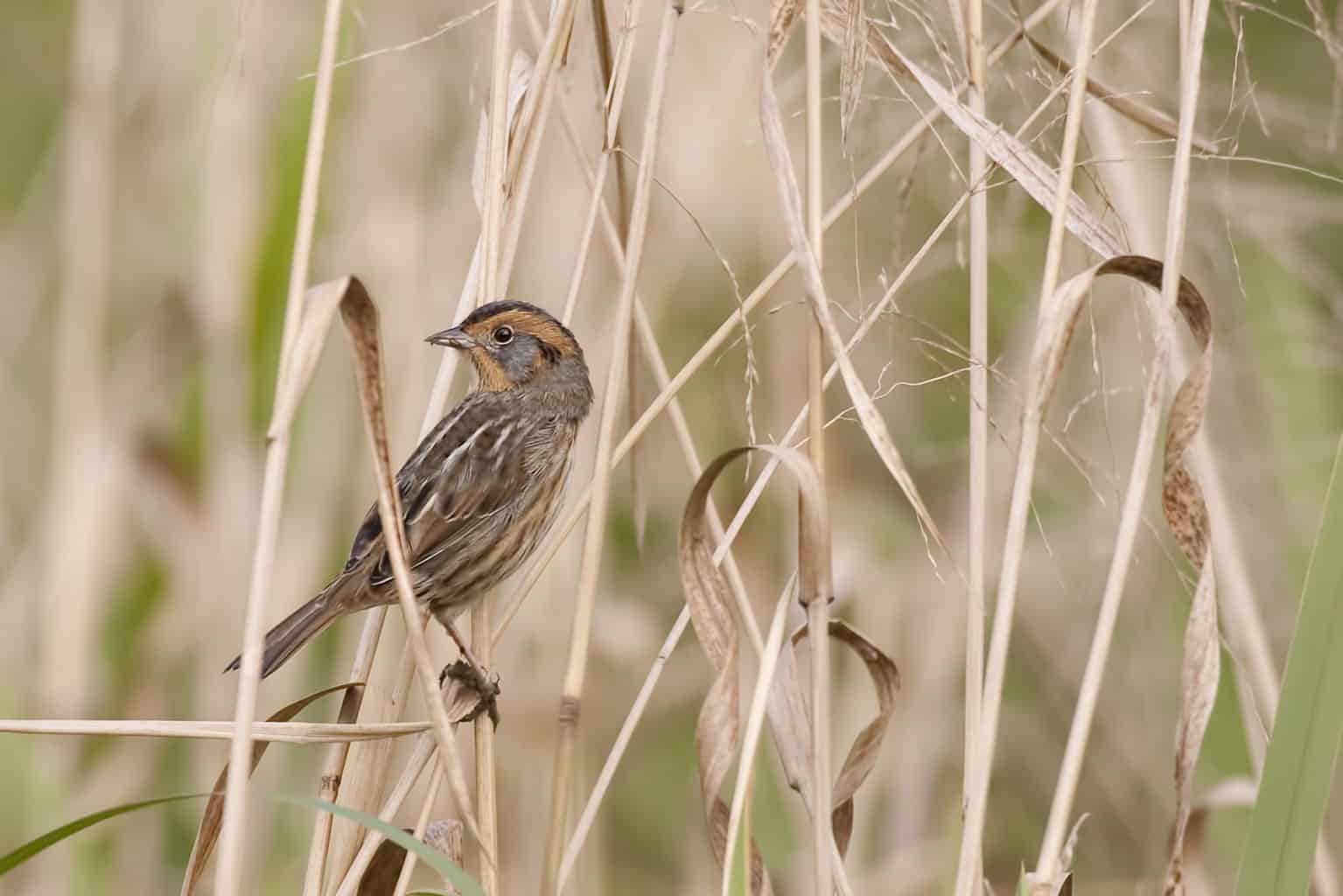
- Scientific name: Ammodramus nelsoni
- Order: Passeriformes
- Family: Emberizidae
- Length: 5.1-5.7 inches (13-14 cm)
- Weight: 0.3-0.5 oz (9-14 g)
- Wingspan: 7.1-8.3 inches (18-21 cm)
The Nelson’s Sparrow is one of the more colorful sparrows on our list. It has a yellowish-orange face, a chestnut-colored black, and some yellow across its chest. Until 1995, the Nelson’s Sparrow was considered the same species as the Saltmarsh Sparrow. They were called the Sharp-tailed Sparrow.
Nelson’s Sparrows breed in Central Canada, along the Hudson Bay, and around the Gulf of St. Lawrence around Maine. Then, they spend the winter on the Atlantic and Gulf Coasts. They only migrate through a small part of Pennsylvania – the Northwest corner, along Lake Erie.
They tend to visit coastal and lakeside marshes as they migrate, which makes Lake Erie a perfect place to stop.
Swamp Sparrow

- Scientific name: Melospiza georgiana
- Order: Passeriformes
- Family: Emberizidae
- Length: 5.1-5.7 inches (13-14 cm)
- Weight: 0.4-0.6 oz (11-16 g)
- Wingspan: 7.1-8.3 inches (18-21 cm)
The Swamp Sparrow is darkly colored with a chestnut-colored cap, white throat, gray breast and nape, and rusty-brown wings. They have long legs for foraging in muddy wetlands.
Their name reveals their habitat needs: Swamp Sparrows are almost always spotted near water. Although they may migrate through drier areas, they will stop in wet fields and in places where there is plenty of protective cover.
In Pennsylvania, Swamp Sparrows are found in the Appalachian range during the summer. On the east and west sides of the state, they are year-round residents.
Swamp Sparrows eat insects during the summer, and berries and seeds during the winter. They are far less shy than other sparrows and can sometimes be coaxed out of their hiding spots by making a “pish-pish-pish” song or a squeak.
White-crowned Sparrow
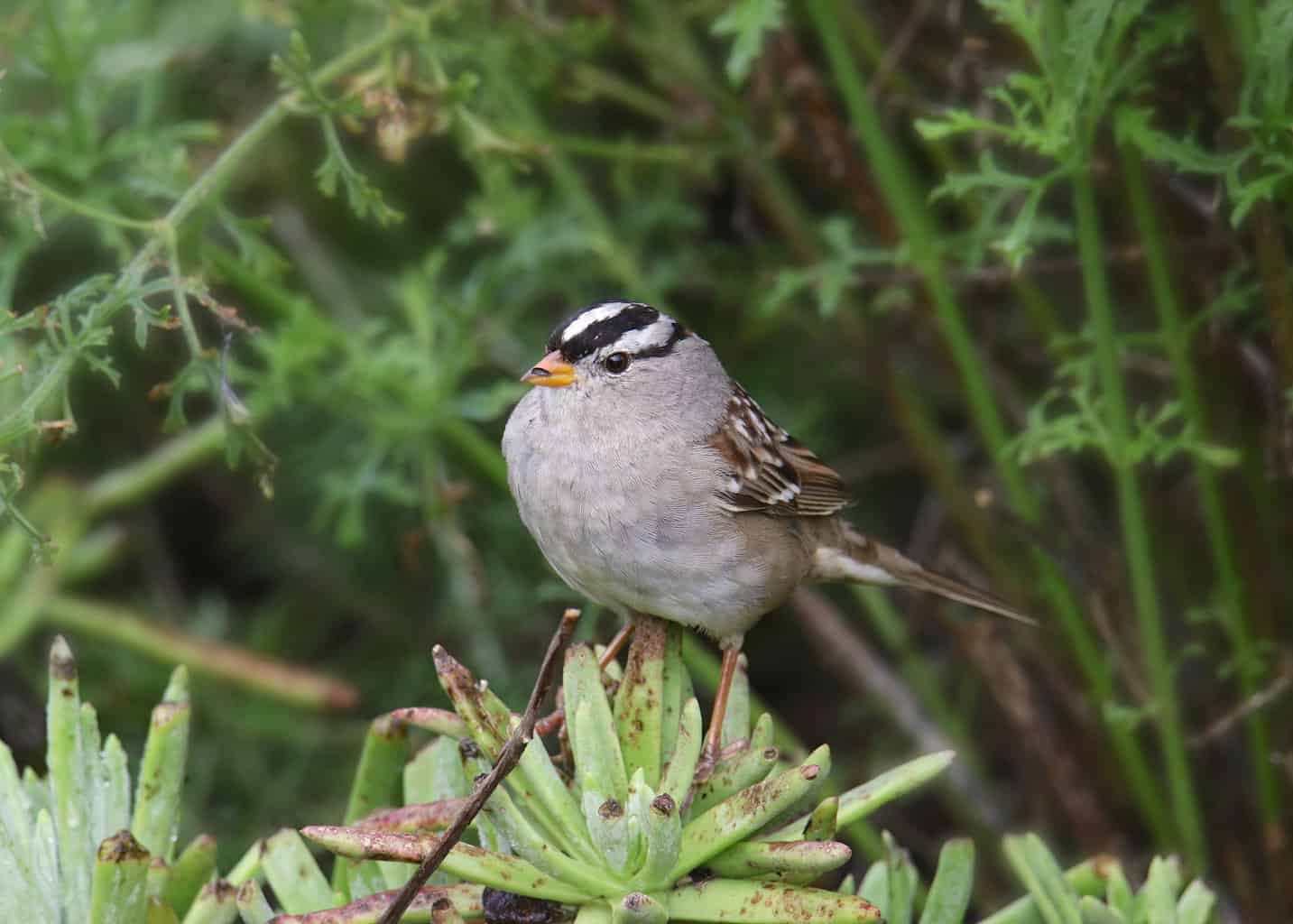
- Scientific name: Zonotrichia leucophrys
- Order: Passeriformes
- Family: Emberizidae
- Length: 6.3-7.5 inches (16-19 cm)
- Weight: 0.7-1.1 oz (20-30 g)
- Wingspan: 9.8-11.8 inches (25-30 cm)
The thick, white stripe on the top of the White-crowned Sparrow‘s head makes it stand out from the other sparrows on this list. This stripe is also lined in black, then again in white, like a zebra.
It has a gray neck, nape, and cheek, plus a thick black eyeline. It has dark brown wings that are streaked with white.
White-crowns Sparrows have an interesting habit of living peaceably with Fox Sparrows but chasing away any Chipping Sparrows and Dark-eyed Juncos who try to share their territory. Both males and females sing, but males are much more vocal.
They migrate through most of Pennsylvania, but they also spend the winter in the southeast corner of the state.
Have Fun Spotting Sparrows in Pennsylvania!
Now that you know some of the key differences between the kinds of sparrows in PA, we hope you are ready to get started! If you’re feeling overwhelmed, take it slow and try to learn the features of one or two sparrows at a time. You probably won’t encounter all of these sparrows right away, so you have time to learn and remember!
If you want to learn about other incredible birds in PA, don’t forget to check out our additional guides. They include:
- 9 Owls in Pennsylvania
- 20 Ducks in Pennsylvania
- 9 Hawks in Pennsylvania
- 8 Woodpeckers in Pennsylvania
- 7 Hummingbirds in Pennsylvania
We hope you have fun identifying Pennsylvania’s diverse and thriving birdlife!

